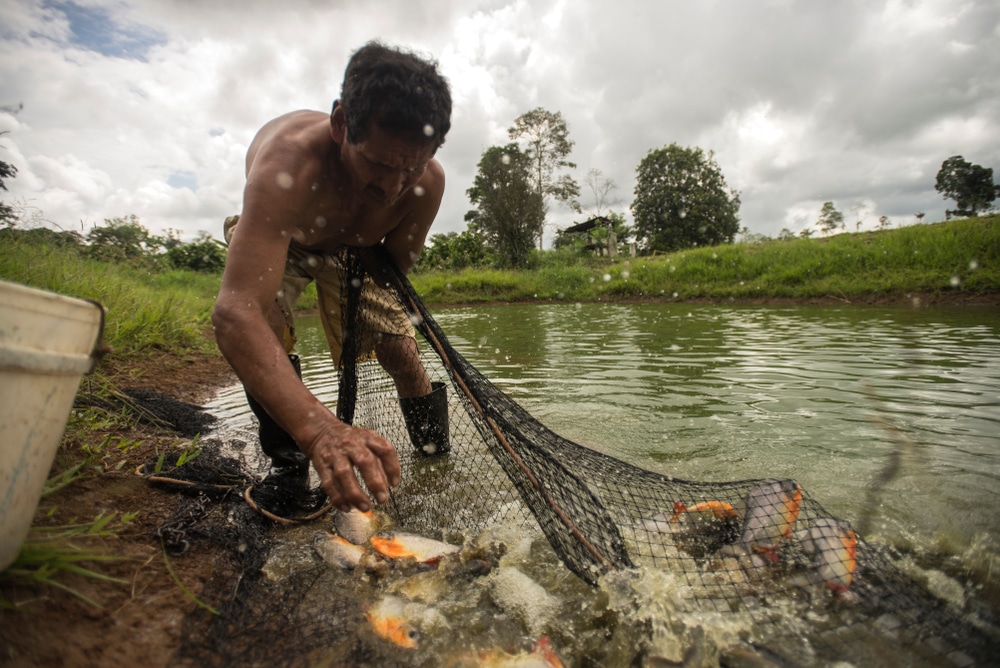Tilapia is a freshwater fish often found in shallow rivers, lakes, and waterways.
You can sometimes find them in brackish ponds and swampy areas – the backflow of rivers and oxbow lakes, but for the most part you find them in rivers.
Tilapia are also most vegetarian.
They eat algae and vegetation but will happily eat small creatures such as worms.
Targeting Tilapia is not difficult. They are fun fish with fast and furious action.

Contents
Rod and Gear for Tilapia
The best method to target Tilapia is with a rod and reel and a good sampling of bait. Rod choice is key.
Choose a 6-8 foot rod with fast action and a medium power.
The reel should be in the 2,500-3,000 series range, and you can choose braided (15-20 pound test), mono, or fluorocarbon in (15-20 pound test.)
Hook size is #2-4.
Bait Options for Tilapia
Corn is one of the best baits for Tilapia.
You can make or buy small bait balls and stuff them with sweet corn.
Other options include bread balls.
You can use minnows and worms also.
Tilapia are very territorial, and they may strike out at small fish that enter their area.
To make a bait ball, you use a piece of netting. Cut it into a square – start with a 3″x3″ square.
You can adjust the size as you get used to making these.
You place a teaspoon to a tablespoon of sweet corn kernels in the center of the netting, gather the corners together and then tie the netting closed using fly-tying thread.
Trim the excess netting away and place the bait ball on your hook.
A good tip is to make up several dozen of these at a time.
Take as many as you need with you, and you can opt for different types of vegetables in them.
Corn works well.
Peas can also be good as is bread.
If bait balls are not your idea of a good time, you can thread a worm onto the hook and give it a go.
Tilapia like worms too.
Another option for fishing Tilapia is a throw net.
Generally, these are monofilament netting in a circle that you toss out into the river or delta.
They close and you can draw them back. Throw nets are not legal in all water bodies so be sure to check the regulations for where you want to fish.
If you are fishing in marshes or along lakes, you can bowfish for Tilapia.
Once you find a pocket of Tilapia you can target them all day long.
You will find Tilapia along the weedy beds because that is what they eat. Be still and patient, and the fish will emerge to feed.
Once you see them, site, fire, and reel them onto the shore.
A pair of polarized sunglasses are essential for bowfishing.
The polarization of the glasses will cut the glare and allow you to see into the water.
Choosing the Best Rod Setup
The best rod is one that has a fast action and medium to medium-heavy power rating.
The length can range from six feet to nine feet – though longer or shorter will work.
For reels, you want one that is in the 2,500-3,000 range – spinning or baitcasting are fine.
You can fly fish for Tilapia too. The same type of criteria for fly-fishing as for spin casting in terms of rod choice.
It is important to balance your rod so reel weight and rod length are important options.
Because you are mostly fishing with baits, you will choose a balance position with the tip up for quick hook setting.
Line options are 100 percent up to you.
If you love braided line, go for it.
You want a 15-20 pound test braid. If you want to fish for more options that just Tilapia, then you may want to choose mono or fluorocarbon lines.
Again 15-20 pound test is cool.
Rigging – You will need a bobber or float – medium is a good option.
You will need a bullet or slide sinker say a 2-3 ounce range works.
You can go heavier if you need to cast farther, but not more than four ounces.
Sinker choice needs to balance with the float.
The idea here is to keep your hook off the bottom and out of the weeds.
There is also a bit of conflict between anglers.
Some believe Tilapia to be a bottom feeding fish, since they are mostly vegetation consumers.
Others find that the sweet spot for targeting Tilapia is the mid-water range.
For the most part, you will find that about 2-3 feet off the bottom is ideal.
That is how you want to rig the line for Tilapia.
They will come off the bottom and out of their burrows to strike quality bait.
Tilapia Behavior
Tilapia are cichlids. These are mostly fish that dig a burrow and hang out in the burrow.
They are territorial and will chase off any other fish that come near their burrow.
If they are in pairs and have young, they will be highly aggressive.
Their feeding habits are to lurk, snatch, and return to their burrow.
You can turn that information to your advantage by allowing bait to float just off the bottom and down the water column.
In still water settings – oxbow lakes, and ponds, you will cast out farther and retrieve the bait slowly.
If you are fishing with minnows as bait, try to use a flick motion to retrieve the minnow.
Rinse and repeat for best application.
A pro-tip for catching Tilapia is to wait until the sun is up, and the water is warming to fish them.
They tend to be lazy sleepers and rise much later than other types of fish.
Selecting a Great Location
Shallow rivers are a good spot to fish Tilapia. You want to look for weedy beds where the fish can find shelter and food.
Small ponds, oxbow lakes, and lakes are also excellent spots for Tilapia.
Marsh settings, bayous, and wetlands can also be an ideal location for Tilapia.
These are fish that will want slower water, but you may find them at the bottom of riffles if they are out of their burrows and hunting.
They will use structures to dig burrows so look for sunken logs, rocks, and other objects that will provide them with protection and calmer water.
When Is the Best Time to Catch Tilapia
Unlike many other fish that spawn once and then call it quits for the year, Tilapia continues to spawn as often as necessary.
They will spawn throughout the warm season until the water temperature drops below 60° F.
For many areas, that can be from mid-spring until late winter.
Tilapia are more easily caught with a hook and line during their spawning season.
Once they have laid eggs, they may not eat again until the eggs hatch and the fry grow.
They are very protective of their young and will generally not leave their burrow unless to defend it.
For that reason, the spawning season is the best time of the year to target Tilapia.
Tips on How to Catch Tilapia
- Fish in the bottom third of the water column, but never on the bottom. If you fish the bottom you will spend most of the time trying to get your hook unstuck or your lure out of the weeds.
- Use Vegetables with a stink trail – stinky-baits, bread balls, and netted vegetables, such as sweet corn for baits -worms and minnows may also work.
- Balance the bobber or float to the sinker so that you can see the bobber. The weight should not be so great as to pull the bobber under.
- Dress in neutral colors as Tilapia have good eyesight.
- Invest in quality polarized sunglasses for spot fishing
- Fish Tilapia from sunup until sundown. They are not early morning fish nor do they usually bite at night.
- Use wet flies in silvery tones and minnow patterns if you plan to fly-fish Tilapia.







